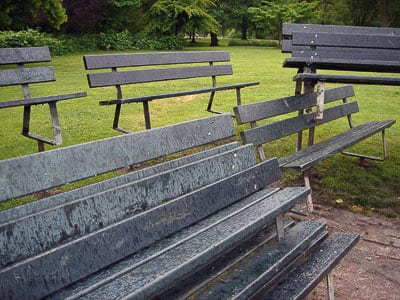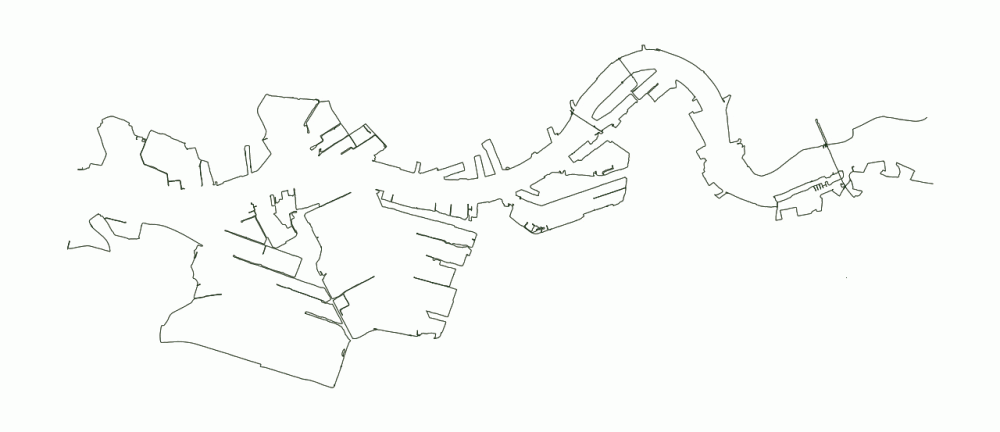As the first pair of artists in this series examined the semantics of local places, and the second explored the possibility of picturing the world in totality, both artists in the final pairing investigate the question of geographic epistemology—how do the material facts of the external world become the objects of systematic human understanding? Together, they demonstrate that while many contemporary media artists enthusiastically embrace the possibility of the digital as a means of connectivity, others continue to thematize the critical distance between terrain and data, between site and non-site, which was so important to the art of the late 1960s.
Jeremy Wood’s The Permissible Edge (2011)
While the works of creators such as John Luther Adams and Greg Niemeyer are predicated on the live input of geological and meteorological data, Jeremy Wood’s practice has consistently aimed to explore the technological and social conditions that make such constant information flow possible in the first place. For the past decade, Wood has been making a series of what he calls “GPS drawings”: graphic works made by plotting a physical journey, often of hundreds of miles long, via constant GPS tracking1. Many of the pieces, which may be considered closer to something like “data self-portraiture,” simply record Wood’s day-to-day travels. In others, like Junior (2013), Star Flights (2008), and Vegas Dollar (2004), Wood traces elaborate pictographic patterns over an expansive landscape. However, Wood’s work is also involved in testing the limits of the GPS technology on which his art depends. For Data Cloud (2008), exhibited in Amsterdam’s Beatrixpark, Grant placed GPS trackers underneath a pair of rarely used benches. After documenting the reported location of the benches every ten seconds for a minute, he produced twelve new replica benches that he installed at the not entirely accurate positions that the GPS system had sited the original benches. The result was a physical version of a digital sampling error, a glitch-like profusion of homely park benches stacked over, under, and beside one another.

More recently, Wood has aimed to incorporate this technological and cartographic slippage into his mapmaking practice. As part of the 2011 exhibition Land Art for a New Generation at the MAMA project space in Rotterdam, Wood exhibited The Permissible Edge, a GPS drawing that attempted to precisely retrace 125 kilometers of the banks of the local Nieuwe Maas distributary. Though the section Wood followed has been fundamentally altered by human intervention—the natural curves of the river regularized by bridges, dams, piers, and other constructions—his path was still unable to truly follow the edges of the dynamic body of water.

As Wood observed of this tension between a dynamic referent and its static representation, “The river on the map does not move. It doesn’t swirl, bubble or gargle. . . .We find the river on the map. It’s the solid line that flattens the ripples. All the shimmering reflections are reduced to a single blue.”2 The GPS drawing generated by Wood’s journey around the Nieuwe Maas lands somewhere between these poles; while it necessarily fails to attend to the ebb and flow of the river itself, it must at least match the general accuracy, if not necessarily the fine detail, of the renderings of the river on local maps.
Mel Bochner: Measurement and Transparency
Questions of how our mental constructs condition our knowledge about the world around us have been an important touchstone for Mel Bochner throughout his career. Like his friend Robert Smithson, the young Bochner was particularly keen to expose false assumptions of neutrality and transparency in cultural systems for organizing knowledge. While he is best known for his explorations in the terrain of natural language—the simple wall painting Language is not Transparent (1969) has become one of his most iconic works—the territory of mathematics was equally central to his early thinking.
This insistence on the false transparency of mathematical language formed the crux of a series of Measurement pieces. Beginning with Actual Size (1968), a pair of photographs of the artist’s face and hand next to a twelve-inch gradation demarcated vertically on the wall, Bochner began to overlay objects with their delineated dimensions. He measured wrapping paper and plants, shadows and rooms. He even measured rulers (Measurement Garden, 1969), a possible allusion to Bertrand Russell’s paradox about sets that include themselves as members. As he explained in a statement to Data magazine in 1972:
“Measurement is one of our means of believing that the world can be reduced to a function of human understanding. Yet, when forced to surrender its transparency, measurement reveals an essential nothingness. The yardstick does not say that the thing we are measuring is one yard long.”3
Bochner emphasized this gap between the world and our representations of it by bringing together the abstractions of measurement and number, forcing them to coexist uneasily in the real space that they typically describe at a remove. By giving measurement an overdone or overwrought transparency—presenting actual-size photographs of the actual size of his own face, or layering blueprints on top of the rooms they describe—he created an estranged environment that pointed to the arbitrariness, the essential nothingness, that underpins our attempts to the know the world as such.
The Houses of Being
Bochner and Smithson mounted a challenge to the assumption that representations of verbal and visual languages were transparent—un-mediating and value neutral. In doing so, they replied to a view of language as fundamentally and deeply grounded in the world outside the mind. This belief, which has ancient roots in the faith placed by numerous religious traditions in the power of the Word, finds a more recent articulation in Martin Heidegger’s famous dictum that “language is the house of Being.”4 For Heiddeger, human language was the medium through which the essence of the world “shined forth,” the intrinsic means through which substance makes itself known to minds. Though this idea has fallen thoroughly out of fashion, it seems to me that a new version of this belief is coalescing at the present moment. Rephrased through Heidegger’s formulation, we might say that we are witnessing a reconceptualization of data as the new house of Being.
Though our own moment is far from unique in its craze for quantification, there is a pervasive contemporary sense that the unprecedented big-ness of our Big Data has broken through a threshold. While Sprint touts its ability to let us record “every second in data dressed as pixels,” an incredible range of artists are drawing on these news data sets, providing visualizations not just of the Earth but of our up-to-the-second human interactions on a global scale. What strikes me as pressing about the emergence of this new trend is the way it seems to naturalize certain kinds of assumptions about the translatability—one might even say fungibility—of the world made into data.
While readers may sense my own skepticism about these assumptions, this series has not been intended to impugn, nor to validate, any of the projects presented. The collapse of a distance between map and territory, object and data, may not be an entirely fair criticism to lay at the feet of new-media artists. The computer, after all, is particularly suited for what Bruno Latour has described as “drawing things together”: gathering dispersed sets of information and translating them so they may be compared with one another.5 In an era of almost instantaneous aesthetic obsolescence, moralizing by art critics has a relevance more fleeting than even the most banal artwork. Rather, I have aimed to demonstrate that no matter how new the phenomenon of Big Data may appear, the artists theorizing a new geography have built on and gathered their meaning through a range of historical precedents.
The only concern for me is the way in which contemporary artists are increasingly prone to treating the new conditions of a seemingly ubiquitous network not simply as a transparent means of accessing the world, but as an increasingly inevitable feature of contemporary life. This inevitability may have a facet of truth. Nevertheless it represents the squandering of one of the great remaining freedoms of artists and theorists, and it ignores the histories of and to fails to imagine different possible futures for how we picture the totality of our world. What is needed is an art, as well as an art theory, that reveals the hidden rhythms of the globe while also pointing us toward the contingency and historicity of our present means of picturing them.
Mike Maizels is teacher, curator, and scholar interested in the long tail of the artistic innovations of the 1960s. His first book, forthcoming from the University of Minnesota Press, focuses on the artist Barry Le Va. A second book, currently in progress, will examine the intersection of experimental art and music in the 1960s. More recently, his research has lead to a larger interest in newer forms of “variable media,” including electronic and digital art. Maizels’s other academic interests include the histories of science and subjectivity, as well as the intersection of art criticism and art history. He is currently the Mellon New Media Curator/Lecturer at the Davis Museum at Wellesley College.
- See Jeremy Wood’s website at www.gpsdrawing.org, as of April 29, 2014. In many ways, this project represents an extension of the drawing-by-walking technique pioneered by Richard Long in works such as A Line Made by Walking (1967). ↩
- Jeremy Wood, “The Permissible Edge,” at http://www.gpsdrawing.com/gallery/water/nieuwe-maas.html, as of April 29, 2014. ↩
- Mel Bochner, “Three Statements for Data Magazine,” Data 5/6 (Summer 1972): 63–67; rep. in Mel Bochner, Solar Systems & Rest Rooms: Writings and Interviews 1965–2007 (Cambridge, MA: MIT Press, 2008). ↩
- Martin Heidegger, “Letter on Humanism” in Martin Heidegger: Basic Writings, 2rd ed, ed. David Krell (New York: HarperCollins, 1993), 236. ↩
- Bruno Latour, “Visualisation and Cognition: Drawing Things Together,” Knowledge and Society: Studies in the Sociology of Culture and Present 6 (1986): 1–40. ↩
